Art Fairs
The 6 Best—and Riskiest—Artworks at Art Basel Unlimited, Where the Fair’s Supersized Artwork Shines
Among the show-stopping works is a Buddhist take on casino capitalism.
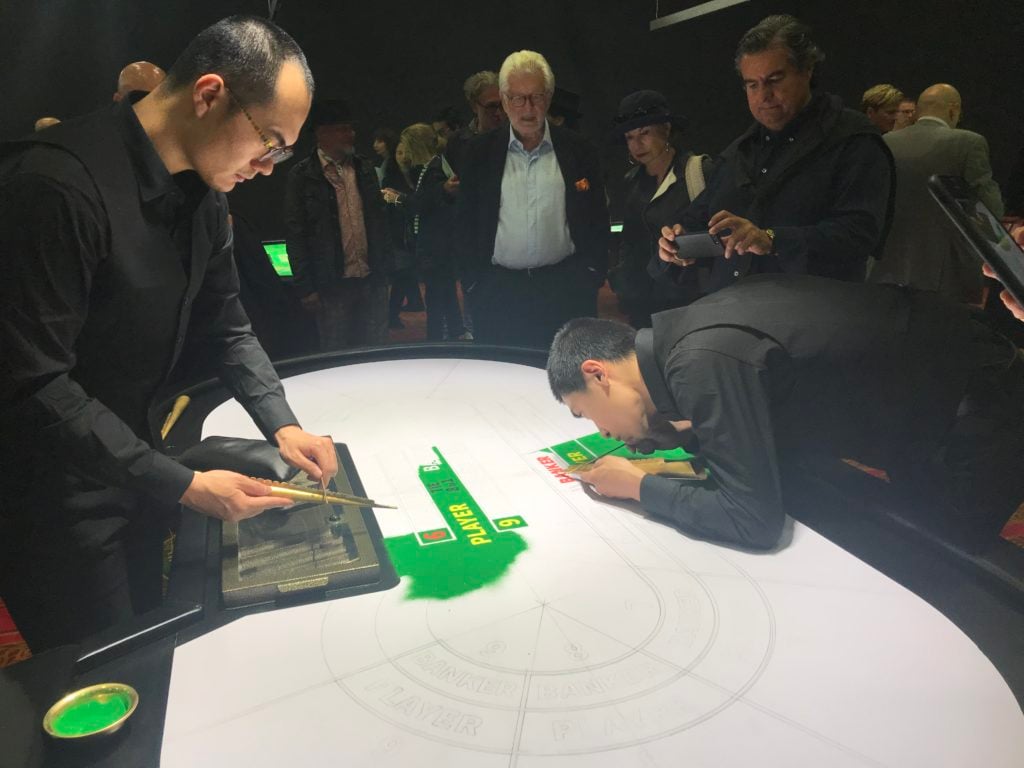
Among the show-stopping works is a Buddhist take on casino capitalism.

Tim Schneider &
Kate Brown

Although Art Basel Unlimited should never be treated as a harbinger of the type of work that galleries will present in the main fair, the 2019 edition of the section manages to deliver the one thing that nearly every fairgoer wants, even if they don’t realize it: risk.
In what is slated to be Gianni Jetzer’s swan-song edition of the section (he has organized it for the past eight years), the curator has brought together a collection of monumental pieces memorable for their ability to walk the wire between spectacle and substance. The best of the lot deftly engage with relevant sociopolitical issues, approach aesthetics with a glint in their eye, or do both.
In the process, they set Art Basel’s Swiss mothership on a compelling path forward. (The main fair opens to invited collectors today.) Will the booths sucking up the majority of the Messeplatz’s oxygen for the next seven days match these works’ vigor? While we wait for what comes next, here are our six standout works at Unlimited 2019.
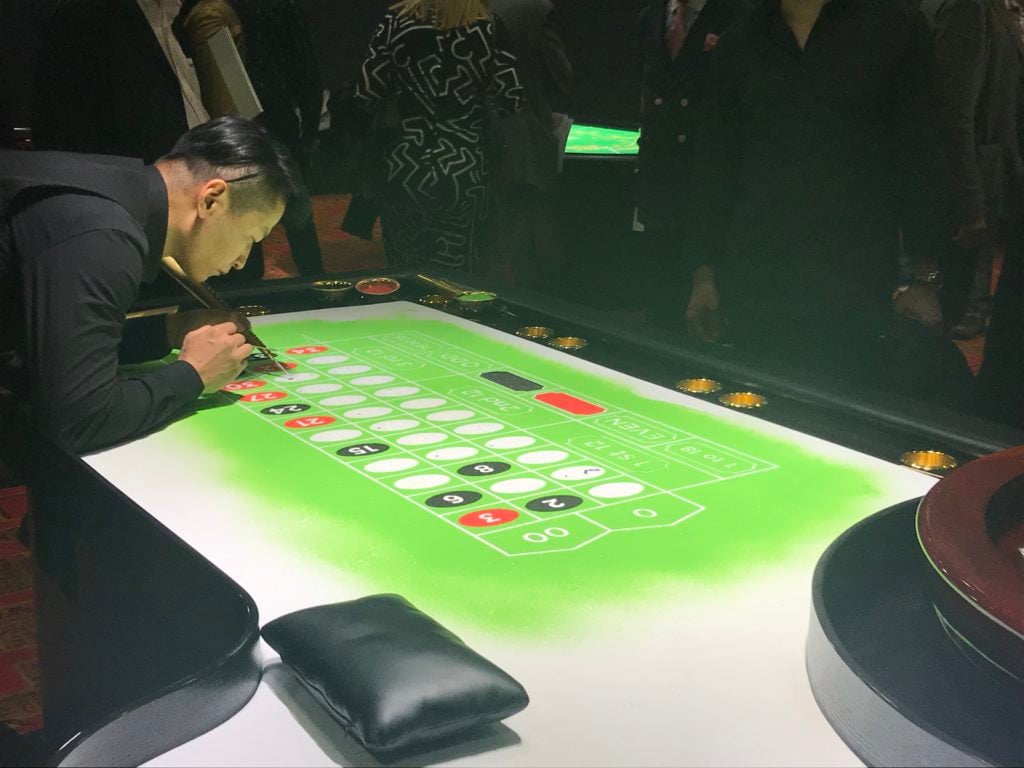
Xu Zhen®, Nirvana (detail) (2019), at Art Basel Unlimited 2019. Photography by Tim Schneider.
In the latest manifestation of a career spent exploring the consonance and dissonance between Eastern and Western cultures, Chinese artist Xu Zhen® presents Art Basel Unlimited’s answer to Casino Night. Six classic table games—roulette and baccarat, to be specific—fill the booth. But instead of felt, their surfaces consist of ephemeral sand mandalas made using the techniques of Tibetan Buddhist monks. Three of the games’ surfaces were complete on Monday evening when Unlimited opened, while one had already been reduced to a schematic diagram overshadowed by a dune of colored sand. Assistants from Xu’s studio will spend the remainder of the week painstakingly rendering the other two tables into functional gaming apparatuses with traditional implements—only to have their work wiped into nothingness at the end of the fair.
According to gallery director Uli Zhiheng Huang, Nirvana channels Buddhism’s embrace of creation and destruction into a “purist versus capitalist” context that gels with Xu’s longstanding concerns.
The entire installation was available for $350,000 at the close of Monday night’s vernissage, but the gallery said individual tables are also available for sale.
—Tim Schneider

Kapwani Kiwanga’s Flowers for Africa: Rwanda (2019) at Art Basel Unlimited 2019. Courtesy the artist, Galerie Jérôme Poggi, Paris, Goodman Gallery, Johannesburg, and Tanja Wagner, Berlin.
Paris-based, Canadian-born artist Kapwani Kiwanga’s monumental installation Flowers for Africa (Rwanda) draws you in first by its smell, before you’ve even turned the corner into the vast hall housing Unlimited.
The site-specific work, a monumental archway of minty-fresh eucalyptus, is part of an ongoing project by the young artist in which she reimages flower arrangements created by various African countries to celebrate their independence days. This iteration—the 13th and largest thus far of her works in the series—recreates the backdrop of the festivities for the country’s independence in 1962. Kiwanga’s gallery says she plans to complete all 54 African countries’ independence day floral displays.
Amid all the flashy colors and glittery surfaces of other works at Unlimited, this towering ephemeral sculpture, already wilting under the lights, is deeply powerful in its transience. For Rwanda, given the tragedy that overcame the country in the early 1990s, this feels particularly searing.
The work is priced at €180,000.
—Kate Brown
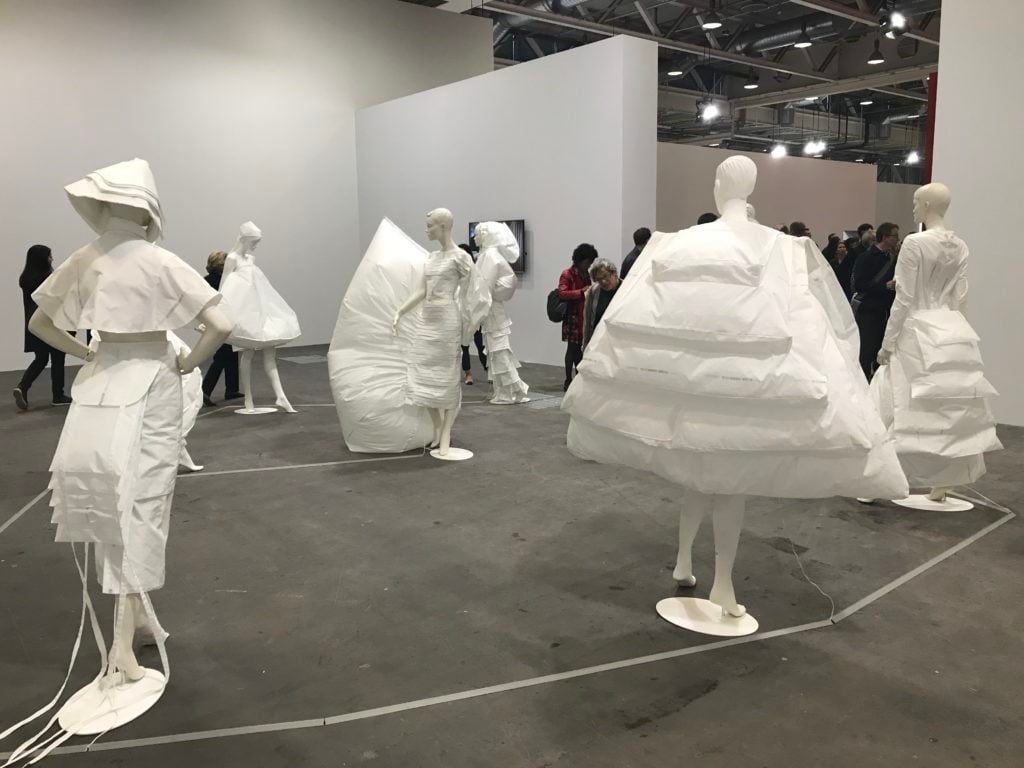
Alicia Framis, installation view of LifeDress at Art Basel Unlimited 2019. Galería Juana de Aizpuru, Seville. Photo by Tim Schneider.
Sometimes reality is so harsh that it warrants a surreal response. The Barcelona-born, Amsterdam-based artist Alicia Framis adopts this attitude in her installation LifeDress, an ensemble of nine women’s outfits fabricated from automobile airbags, each designed to protect the wearer by inflating when they encounter harassment in the workplace.
An air compressor periodically sends the various dresses billowing over their respective mannequins, while an absurdist live-action video shows actual women wearing the same garments in nondescript office environments populated by silent businessmen. The effect hovers somewhere between black comedy and justified alarm, as Framis leaves viewers to contemplate the unforgivable proximity between women’s fashion and vulnerability in contemporary society.
The installation is on sale as a single piece, priced €150,000.
—Tim Schneider
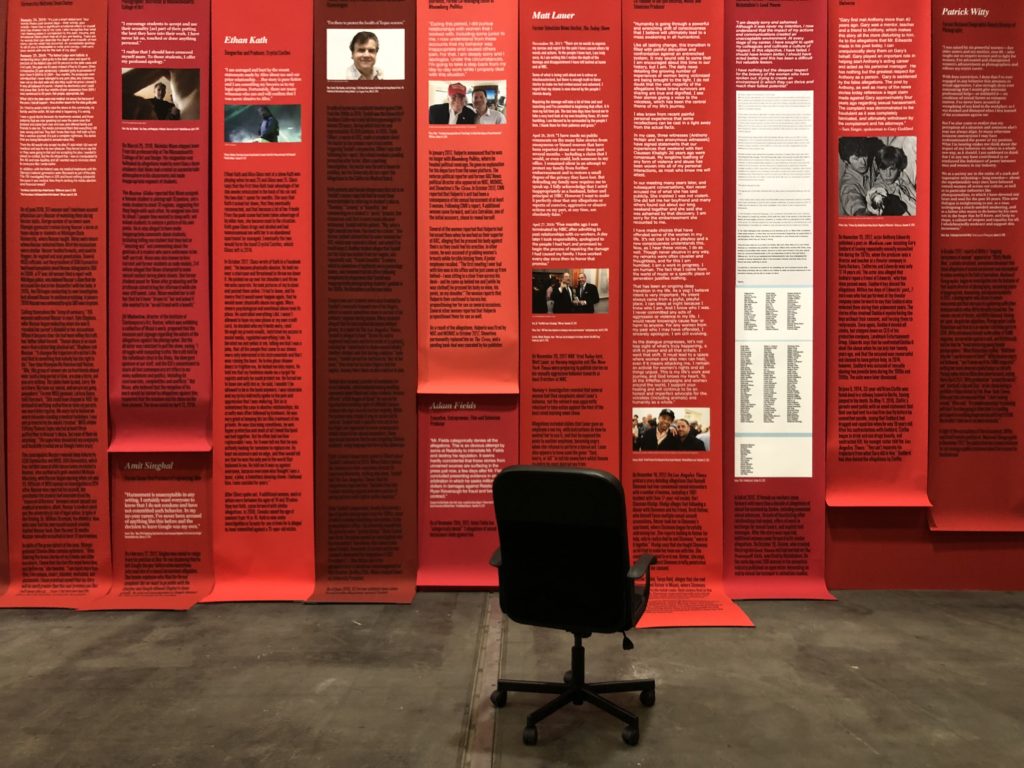
Andrea Bowers Open Secrets (2018) at Art Basel Unlimited 2019. Presented by kaufmann repetto, Andrew Kreps Gallery, Susanne Vielmetter Los Angeles Projects. Photo by Kate Brown.
When Andrea Bowers’s Me Too and Time’s Up “memorial” had its debut in Berlin at Capitain Petzel last year, it was the talk of the town. In Basel, the second manifestation of the US artist’s provocative work, called Open Secrets, meets the international art world as VIPs re-encounter all the familiar faces of men who fell from their powerful positions since the anti-harassment campaign ignited in every corner of the culture industry. The work also sparked controversy when an abuse survivor became aware that her image had been included without her consent; Bowers and her galleries agreed to remove the offending panel.
On red rolls—and doubled in size since its Berlin premiere—Open Secret lists as many as 200 people, including the comedian Aziz Anzari, film producer Harvey Weinstein, and former Artforum publisher Knight Landesman. It also includes the various allegations they face. Visitors can take a seat on office chairs while they read up on each person’s responses to the allegations, some apologetic and some not.
All too often, history has seen progress get rolled back when we forget all the details of a particular struggle. Bowers’s physical manifestation of the Me Too movement, which had its watershed moment largely in the virtual world, remind us of the importance of making it tangible. Open Secret is about continuing to talk about the abuse of power, in all of its nuances.
The work is priced at $300,000.
—Kate Brown
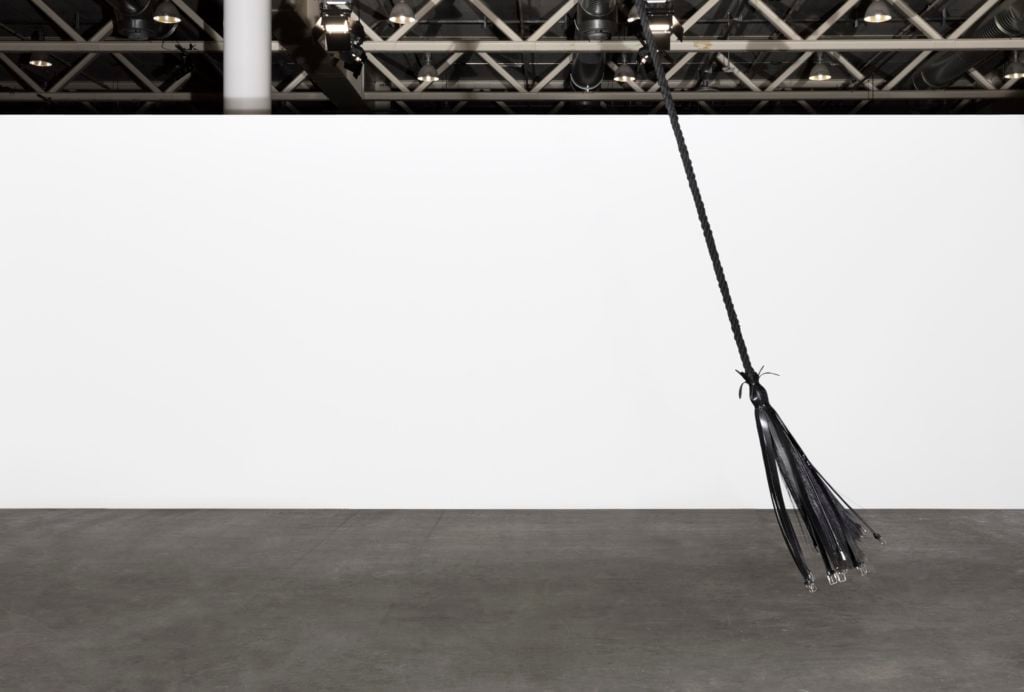
Monica Bonvicini, Breathing (2017). Presented by Galleria Raffaella Cortese, Galerie Peter Kilchmann, Mitchell-Innes & Nash. Photography by Andrea Rosetti. Courtesy of the artist, Galleria Raffaella Cortese, Galerie Peter Kilchmann, and Mitchell-Innes & Nash.
The sound of Bonvicini’s Breathing is not the sound of breath, but it beckons viewers to the kinetic installation all the same. Above the din of Unlimited’s crowd, an overhead array of pistons whirr and snap like the jaws of some iron dragon.
What they control is a hydra of black-leather, silver-buckled “men’s belts” (as they have been described in past installations) sent swinging, clinking, and slashing across the space in irregular patterns. Simultaneously playful and threatening, the work converts what could be read as a symbol of toxic masculinity—husbands and fathers have too often used belts as makeshift bullwhips for domestic abuse—into a tongue-in-cheek totem of feminist power: the witch’s broom. In the process, Bonvicini blends the mechanical and the mystical, the masculine and the feminine, the irreverent and the deadly serious, into a mesmerizing display.
The work is priced at €220,000 and was still available at the end of opening night.
—Tim Schneider
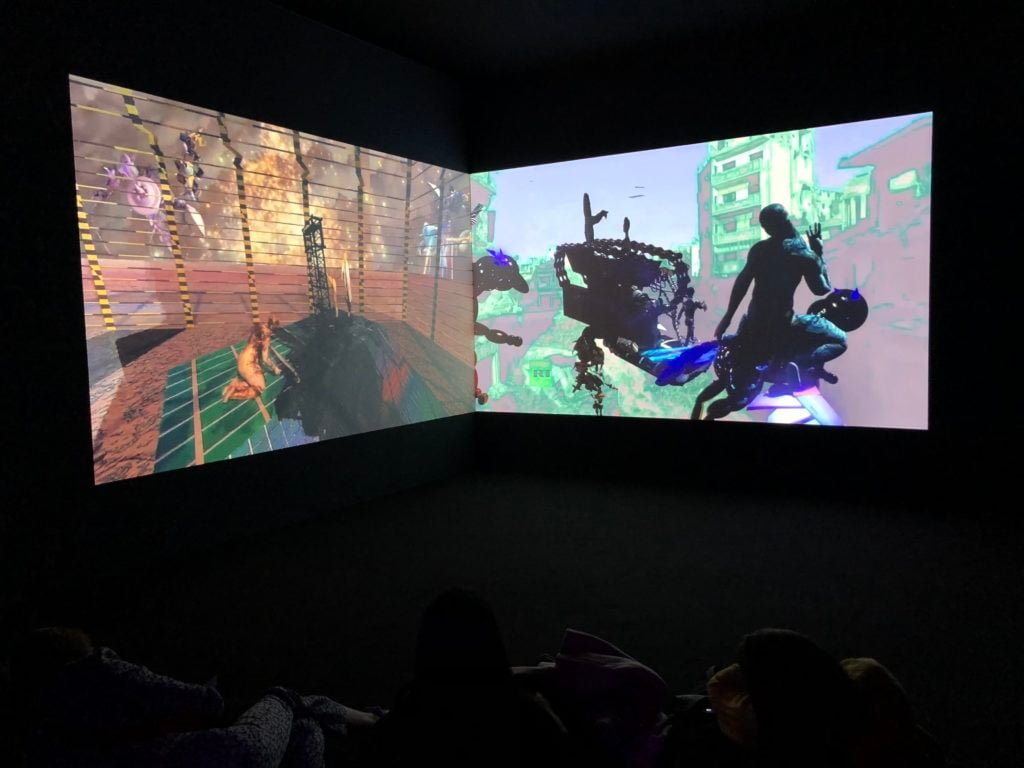
Jacolby Satterwhite’s Birds in Paradise (2019). Presented by Mitchell-Innes & Nash, New York, Lundgren Gallery, Palma, and Morán Morán, Los Angeles.
For his two-channel video Birds in Paradise, Satterwhite imagines a future where BDSM soldiers and queer warriors are prepping to take over in a post-apocalyptic world.
It’s mesmerizing to see this set of video works, which includes Blessed Avenue from Gavin Brown’s show by the same name last spring. On the left-side of the video, Satterwhite gazes out at the audience as he moves through choreography that oscillates between martial arts and Vogue-type dancing. On the right, two digital figures fly triumphantly on Pegasi over flooded US terrain.
On top of it all, we hear a beautiful looping track of Satterwhite’s late mother, Patricia Satterwhite, singing; she was an artist who suffered from mental illness, and she figures powerfully into her son’s practice. Her hauntingly beautiful voice in this piece pulls the work between a soaring sci-fi reality of a totalitarian world and a deeply intimate commentary on love between mother and child.
None of the galleries replied to requests for the price of the work by the time of publication.
—Kate Brown